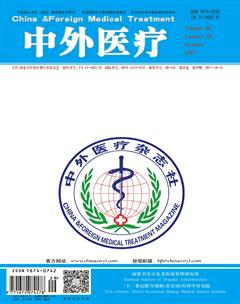乳腺浸润性微乳头状癌淋巴结转移的高危因素及对预后的影响
冯爱强+汪杰+张彦武+牛耀东+吕以东+王璐
[摘要] 目的 探討乳腺浸润性微乳头状癌( Invasive micropapillary carcinoma of, IMPC)患者淋巴结转移的高危因素及对预后的影响。方法 方便选取2007年1月—2013年10月在郑州大学第三附属医院确诊并接受治疗的40例乳腺IMPC患者,收集其一般临床资料、临床病理及免疫组化学特征和预后情况,并分析乳腺IMPC 患者淋巴结转移的高危因素及对预后的影响。结果 该研究中有26例(65%)出现淋巴结转移。单因素Logistic回归分析结果显示:组织学分级、肿瘤大小、Ki-67表达均与淋巴结转移相关(P<0.05),但确诊时年龄、PR、ER、Her-2以及乳腺IMPC所占比例与淋巴结转移均不相关(P>0.05)。多因素Logistic回归分析结果显示:乳腺IMPC患者的淋巴结转移和肿瘤大小(β:1.484,标准误:0.797,P=0.063)及Ki-67(β:1.497,标准误:1.358,P=0.278)均无相关性,只有组织学分级(β:2.392,标准误:1.105,P=0.030)是淋巴结转移的独立危险因素。预后情况:乳腺IMPC患者的5年总生存率为88.4%,淋巴结转移率与总生存率无相关性。结论 乳腺IMPC的淋巴结转移率高、侵袭性强,预后较差的一种乳腺浸润性癌,肿瘤的组织学分级是淋巴结转移的独立危险因素。在临床治疗时应充分重视这些因素,制定合理的治疗计划,提高患者的生存率。
[关键词] 乳腺浸润性微乳头状癌;病理特征;淋巴结转移;预后
[中图分类号] R737.9 [文献标识码] A [文章编号] 1674-0742(2017)10(b)-0007-05
[Abstract] Objective This paper tries to explore the high risk factors of lymph node metastasis in invasive micropapillary carcinoma (IMPC) of the breast and its influence on prognosis. Methods From January 2007 to October 2013, 40 cases of IMPC were diagnosed and treated in this hospital and their general clinical data, clinical pathological and immunohistochemical features and prognosis were convenient collected. The high risk factors of lymph node metastasis in IMPC and its influence on prognosis were analyzed. Results 26 patients (65%) had lymph node metastasis in this research. The results of univariate logistic regression analysis showed that histological grading, tumor size and the expression of Ki-67 were correlated with lymph node metastasis(P<0.05). However, age, PR, ER, HER-2 and proportion of IMPC had no effect on lymph node metastasis (P>0.05). The results of multivariate logistic regression analysis showed that tumor size (β=1.484, standard error=0.797, P=0.063) and the expression of Ki-67 (β=1.497, standard error=1.358, P=0.278) had no correlation with lymph node metastasis, which was associated with histological grading (β=2.392, standard error=1.105, P=0.030). Prognosis: overall survival rate of the patients was 88.4% at 5 years, and there was no correlation between lymph node metastasis rate and overall survival rate. Conclusion This kind of breast IMPC always has higher histologic grade, stronger invasion and poor prognosis. Histologic grading of the tumor is an independent risk factor for lymph node metastasis. In clinical treatment, these factors should be paid full attention to, and the reasonable treatment plan should be made to improve the survival rate.
[Key words] Invasive micropapillary carcinoma (IMPC) of the breast; Pathologic features; Lymph node metastasis; Prognosisendprint
乳腺浸润性微乳头状癌 (IMPC) 是一类少见的乳腺恶性肿瘤。1980 年,外国研究者[1]首先报道了桑葚样形态学变化的浸润性乳头状癌的结构 ,1993 年,Siriaunkgul等[2]通过对乳腺IMPC 病例的研究给出了 IMPC 的定义,定义为在类似脉管的间质缝隙中成簇排列的肿瘤细胞构成的浸润性癌,其形态类似于微乳头状导管内癌。国内学者丁岚[3]2001年首次报道该病例。WHO(2003 版)乳腺肿瘤组织学分类,将其定义为透明间质内瘤细胞的组成类似于扩张的血管腔并成簇状分布,且被正式划分为一种新的乳腺肿瘤类型。2012版WHO肿瘤分类,也将其定义为浸润性乳腺癌的独立亚型。因其在乳腺癌中发病率较低,临床医师往往容易忽视,目前并没有针对其建立特殊的治疗方案,对IMPC的基本治疗也与浸润性性导管癌(IDC)类似。该研究方便选取2007年1月—2013年10月在郑州大学第三附属医院确诊并接受治疗的40例乳腺IMPC患者,观察截止时间至2016年10月。对40例患者的临床资料进行归纳总结,探讨淋巴结转移与临床病理特征和预后的关系,这对于指导临床治疗以及进一步深入研究有着重要的意义,现报道如下。
1 资料与方法
1.1 一般资料
在该院确诊并接受治疗的900例女性乳腺癌患者中,方便选取40例乳腺IMPC患者纳入该研究。纳入标准:纳入患者均为可手术患者患者入院前均未行手术、化疗、内分泌治疗以及靶向治疗; 所有患者的术后病理切片均由该院病理科統一处理并明确病理诊断为乳腺IMPC,并根据2012年WHO乳腺肿瘤病理分类标准进行组织学分类;患者均有完整的临床资料和随访资料。排除标准:剔除非IMPC患者病理诊断为IMPC但伴有远处转移 经外院病理诊断为乳腺IMPC的患者。
1.2 研究指标
一般临床资料:年龄、肿瘤直径、淋巴结状态。临床病理及免疫组化指标:组织学分级、雌激素受体(estrogen recepto,ER)、孕激素受体(progesterone receptor,PR)、人表皮生长因子受体2(human epidermal growth factor receptor 2,HER-2)及Ki-67。免疫组化判断标准:肿瘤细胞中细胞核内棕黄色染色超过 1% 判定为 ER、PR 阳性[4],HER-2阴性指IHC 0或(+),(++)者行FISH检测阴性,(+++)者为阳性[5];KI-67阳性细胞多数为核染色,呈棕黄色;以>14%作为 Ki-67高表达的界值[6]。随访:随访时间为手术之日起至末次随访时间或疾病局部复发、远处转移、死亡;随访方式主要为门诊复查或电话随访;观察时间截止为 2016年 10 月,随访时间为19~117个月,中位随访时间为62个月。
1.3 统计方法
采用 SPSS 21.0 统计学软件分析数据。单因素和多因素分析采用Logistic回归分析,Kaplan-Meier法计算生存率,Log-rank检验进行组间差异比较。P<0.05为差异有统计学意义。
2 结果
2.1 单因素Logistic回归分析
所有患者中共26例(65%)出现淋巴结转移,分析结果显示:组织学分级、肿瘤大小、Ki-67表达均与淋巴结转移相关(P<0.05),确诊时年龄、PR、ER、Her-2以及乳腺IMPC所占比例与淋巴结转移均不相关(P>0.05),见表1。
2.2 多因素Logistic回归分析
多因素 Logistic回归分析结果显示:乳腺IMPC患者的淋巴结转移和肿瘤大小(β:1.484,标准误:0.797,P=0.063)及Ki-67(β:1.497,标准误:1.358,P=0.278)均无相关性,只有组织学分级(β:2.392,标准误:1.105,P=0.030)是淋巴结转移的独立危险因素,见表2。
2.3 随访结果及预后
所有患者均获得随访,随访率100%,随访时间为为 19~117个月,中位随访时间为62个月,10例患者复发,6例患者死亡,5年总生存率为88.4%,患者的总生存率见图1。淋巴结转移率与总生存率无相关性,淋巴结转移率与总生存率的关系见图2。
3 讨论
近年来因为乳腺IMPC诊断标准的不统一以及其特殊的生物学表现,逐渐受到广泛学者的关注。乳腺IMPC最显著的生物学特点就是具有高侵袭转移和局部复发,大部分患者初次就诊时一般都伴有淋巴结转移和脉管癌栓侵犯[7]。乳腺IMPC多好发于中老年女性,患者多因乳房不明原因肿块就诊,发病年龄、临床表现、体格检查等与非特殊性浸润性癌相比差异无统计学意义。乳腺IMPC在所有乳腺癌的发生中约占2.6%~6.0%[8-12]的比例。该研究中收集了900例乳腺癌患者临床资料,其中乳腺IMPC患者约为4.4%与文献报导基本一致,其中单纯型乳腺IMPC 3例,混合型乳腺IMPC 37例,单纯型乳腺IMPC的比例远远低于混合型乳腺IMPC。因为单纯型乳腺IMPC的发生率极低,且该研究随访时间较短,故没有对单纯型与混合型乳腺IMPC进行比较研究。目前对于混合型乳腺IMPC中占比多少应该诊断为IMPC国内外学者尚没有统一的意见。国外学者Ide等[13]认为不管乳腺IMPC在癌巢中占多少比例,其淋巴结转移率和预后均差异无统计学意义。国内学者付丽等[14]的研究同样也表明:只要伴有IMPC成分的乳腺癌患者其淋巴结转移率和局部脉管癌栓侵犯率显著患者高于不伴IMPC成分乳腺癌患者,即使伴IMPC的成分在25%以下甚至10%,其恶性程度也明显高于不伴有IMPC成分的患者,且所占比例的多少与淋巴结转移率无显著相关性[15]。目前此标准被国内外学者广泛引用参考[16-18]。因此基于这些研究可以认为只要乳腺癌的癌巢中伴有IMPC成分就可以诊断为乳腺IMPC,在明确诊断的同时需要注意癌巢中IMPC所占的比例。endprint
绝大多数学者认为乳腺IMPC具有较高的的淋巴管和局域淋巴结转移率,该研究中乳腺IMPC的淋巴结转移率为65%,与前期文献报道基本相似。因此对于乳腺IMPC的淋巴结转移单因素logistic回归分析结果显示,患者的年龄、PR、ER、Her-2的表达以及乳腺IMPC所占比例的多少与淋巴结转移均无相关性,而组织学分级、肿瘤大小、以及Ki-67的高表达是淋巴结转移的高危因素。多因素Logistic 回归分析显示,肿瘤的大小与Ki-67的表达与淋巴结的转移无关,组织学分级是腋窝淋巴结转移的独立危险因素, 乳腺IMPC的嗜淋巴性与其组织学分级较高有关。郭晓静等[19]报道乳腺IMPC组织病理学分级、淋巴管密度及间质内淋巴细胞浸润,可能是影响淋巴结转移的关键性因素,同时VEGF-c和VEGFR-3高表达是促使乳腺IMPC发生淋巴结转移的重要因素。所以对于乳腺IMPC的后续研究以及相关治疗方案的制定中,都应该重视这些因素,在综合考虑这些因素后制定合理的方案。
目前,关于IMPC淋巴结转移机制并不完全明确。Acs等[20]的研究推测肿瘤出现细胞的极性倒转这种特征,可能与肿瘤的淋巴结转移有关。IMPC的肿瘤细胞排列成桑葚样,细胞团不含纤维束及假腺管,外周肿瘤细胞的极向朝向癌巢间隙,这种特殊的结构特征,称之为结构倒转。这种极性倒转的结构特征,使腺腔分泌的黏蛋白容易分布到细胞团外面。当这种肿瘤细胞极性发生改变或伴发上皮间质转化时,肿瘤更容易发生侵袭和转移[21]。这些相关研究均可提示IMPC特殊的形态学特征和其较高的生物學侵袭性存在着密切关系,但是目前关于IMPC极性倒转的发生机制尚无相关文献报道。
由于乳腺IMPC具有较高的侵袭性、淋巴管及淋巴结转移率,一般提示其较差预后,Chen等人[22]对 2001—2008 年共 624 例乳腺 IMPC 患者进行预后标记物研究后得出数据:其5年疾病特异生存率(DSS)及总生存率(OS)分别为 91.9%及83.8%。该研究中对于40例乳腺IMPC患者的随访中,有6例患者死亡,5年生存率为88.4%,比前期文献稍高,这可能与不同文献的诊断标准、样本数量以及近年来多西他赛的应用和内分泌治疗的普及有关,乳腺IMPC在系统化的全身全程治疗下可以显著提高患者的总生存率。目前临床上对于IMPC的处理与IDC基本一致。手术方式的选择多以标准的改良根治术为主,术后应准确评估腋窝淋巴结状态。Yu等[23]的研究发现,伴有腋窝淋巴结转移的患者经系统治疗后易再次于腋窝及锁骨上区域复发,其原因可能与癌巢的肿瘤细胞具有易脱落性和运动活性以及富含脉管的网状结构有关[24],基于此伴有淋巴结转移的患者术后仍伴有较高的胸壁及锁骨上区域的局部复发。因此对于腋窝淋巴结转移阳性的患者,我们放疗的指征可以稍放宽,术后可以考虑进行锁骨上及腋窝区域的放疗。但基于目前随访病例较少,对于淋巴结转移<4枚以及肿块<5 cm患者是否需要加用放疗还需要综合考虑。
该研究通过Log-rank进行不同淋巴结状态的生存率的组间差异比较,结果显示淋巴结转移率与总生存率并无相关性,探究其原因可能跟该研究随访访病例较少、随访时间较短有关。相信随着病例的不断积累,研究的不断深入,对于淋巴结转移与总生存率的关系将进一步明确。
综上所述,乳腺IMPC的淋巴结转移率高、侵袭性强,预后较差的一种乳腺浸润性癌,肿瘤的组织学分级是淋巴结转移的独立危险因素。在临床治疗时应充分重视这些因素,制定合理的治疗计划,提高患者的生存率。
[参考文献]
[1] Bingham HG. Pathologic findings from the National Surgical Adjuvant Breast Project (Protocol No. 4)[J]. Plastic & Reconstructive Surgery, 1985, 76(4):2507-2514.
[2] Siriaunkgul S, Tavassoli FA. Invasive micropapillary carcinoma of the breast[J]. Mod Pathol, 1993, 6(6): 660-662.
[3] 丁岚.乳腺浸润性微乳头状癌1例[J].诊断病理学杂志,2001,8(4): 73,242.
[4] Hammond ME, Hayes DF, Wolff AC, et al. American society of clinical oncology / college of American pathologists guideline recommendations for immunohistochemical testing of estrogenand progesterone receptors in breast cancer[J].J Oncol Pract,2010, 6(4): 195-197.
[5] Sauter G, Lee J, Bartlett JM, et al. Guidelines for human epidermal growth factor receptor 2 testing: biologic and methodologic considerations[J].J Clin Oncol,2009,27(8):1323- 1333.
[6] Goldhirseh A,Winer EP,Coates AS,et a1.Personalizing thetreatment of women with early breast cancer:highlights of the StGallen InternationalExpert Consensus on the Primary Therapy of Early Breast Cancer 2013[J].Ann Oncol,2013.24(9):2206-2223.endprint
[7] Mc Quitty E,Ro JY,Truong LD,et a1.Lymphovascular invasion In micropapillary urothelial carcinoma:a study of 22 cases [J],Arch Pathol Lab Med,2012,136(6):635-639.
[8] Ii Y,Kaneko M,Sakamoto DG,et a1.The reversed apicalpattern of MUCl expression is characteristics of invasivemieropapillary carcinoma of the breastE[J].Breast Cancer,2006,13(1):58-63.
[9] Pettinato G,Manivel CJ,Panico L,et aZ.Invasive micropapillary carcinoma of the breast:clinicopathologic study of 62 cases of a poorly recognized variant withhighly aggressive behavior[J].Am J Clin Pathol,2004,121(6):857-866.
[10] Guo X,Chen L,Lang R,et a1.Invasive micropaplllary carcinoma of the breast.Association of pathologic features with lymph node metastasis[J].Am J Clin Pathol,2006,126(5):740-746.
[11] Lui PC,Lau PP,Tse GM,et al.Fine needle aspiration cytology of invasive micropapillary carcinoma of the breast[J].Pathology,2007,39( 4) : 401-405.
[12] Cui ZQ,Feng JH,Zhao YJ.Clinicopathological features of invasive micropapillary carcinoma of the breast[J].Oncol Lett,2015,9(3):1163-1166.
[13] Ide Y, Horii R, Osako T, et al. Clinicopathological significance of invasive micropapillary carcinoma component ininvasive breast carcinoma[J].Pathol Int, 2011, 61(12):731-736.
[14] 付麗,松山郁生,付笑影,等.乳腺浸润性微乳头状癌的形态改变与生物学行为的关系[J].中华病理学杂志,2004,33(1):21-25.
[15] Chen L,Fan Y,Lang RG,et al.Breast carcinoma with micropap—illary features:clinicopathologic study and long·-term follow-up of 100 cases[J].Int J Surg Pathol,2008,16(2):155-163.
[16] Yang W,Wei B,Chen M,et a1.Evaluation of immunohistochem—istry HER2 results interpretation in invasive micropapillary carcinoma of the breast[J].Chin J Pathol,2015,44(1):48-52.
[17] Furnkawa M,Toyooka S,Ichimura K,et a1.Genetic alterations in lung adenocarcinoma with a micropapillary component[J].Mol Clin Oncol,2016,4(2):195-200.
[18] Bertz S,Wach S,Taubert H,et a1.Micropapillary morphology isan indicator ofpoor prognosis in patients with urothelial carcino—ma treated with transurethral resection and radiochemotherapy[J].Virchows Arch,2016,469(3):339-344.
[19] 郭晓静,陈凌,郎荣刚,等.乳腺浸润性微乳头状癌的病理学特征与淋巴结转移的关系[J].中华病理学杂志, 2006, 35(1):8-12.
[20] Acs G,Esposito NN,Rakosy Z,el a1.Invasive ductal carcinomasof the breast showing partial reversed cell polarity are associatedwith lymphatic tumor spread and may represent part of aspectrumof invasive micmpapillary carcinoma[J].Am J Surg Pathol,2010,34(11):1637-1646.
[21] Gandalovi ova A,Vomastek T,Rosel D,et a1.Cell polarity sig—naling inche e plasticity of cancer cell invasiveness[J].Oncotarget,2016,7(18):25022-25049.
[22] Chen A.C, Paumino A.C, Schwartz M.R, et al. Prognostic markers forinvasive micropapillary carcinoma of the breast: a population-basedanalysis[J]. Clin Breast Cancer, 2013, 13(2): 133-139
[23] Yu, JI,Choi, DH,Park, W,et al.The differences of prognostic factors and pattern of failure between invasive micropapillary carcinoma and invasive ductal carcinoma in breast cancer: matched case-control study[A].15th Congress of the European-Cancer-Organization/34th Multidisciplinary Congress of the European-Society-for-Medical-Oncology[C],2009
[24] 张燕娜,王常珺,周易冬,等.乳腺浸润性微乳头状癌与浸润性癌(非特殊型) 腋窝淋巴结转移相关因素的病例对照研究[J].协和医学杂志,2015,6(3):166-172.
(收稿日期:2017-07-17)endprint

